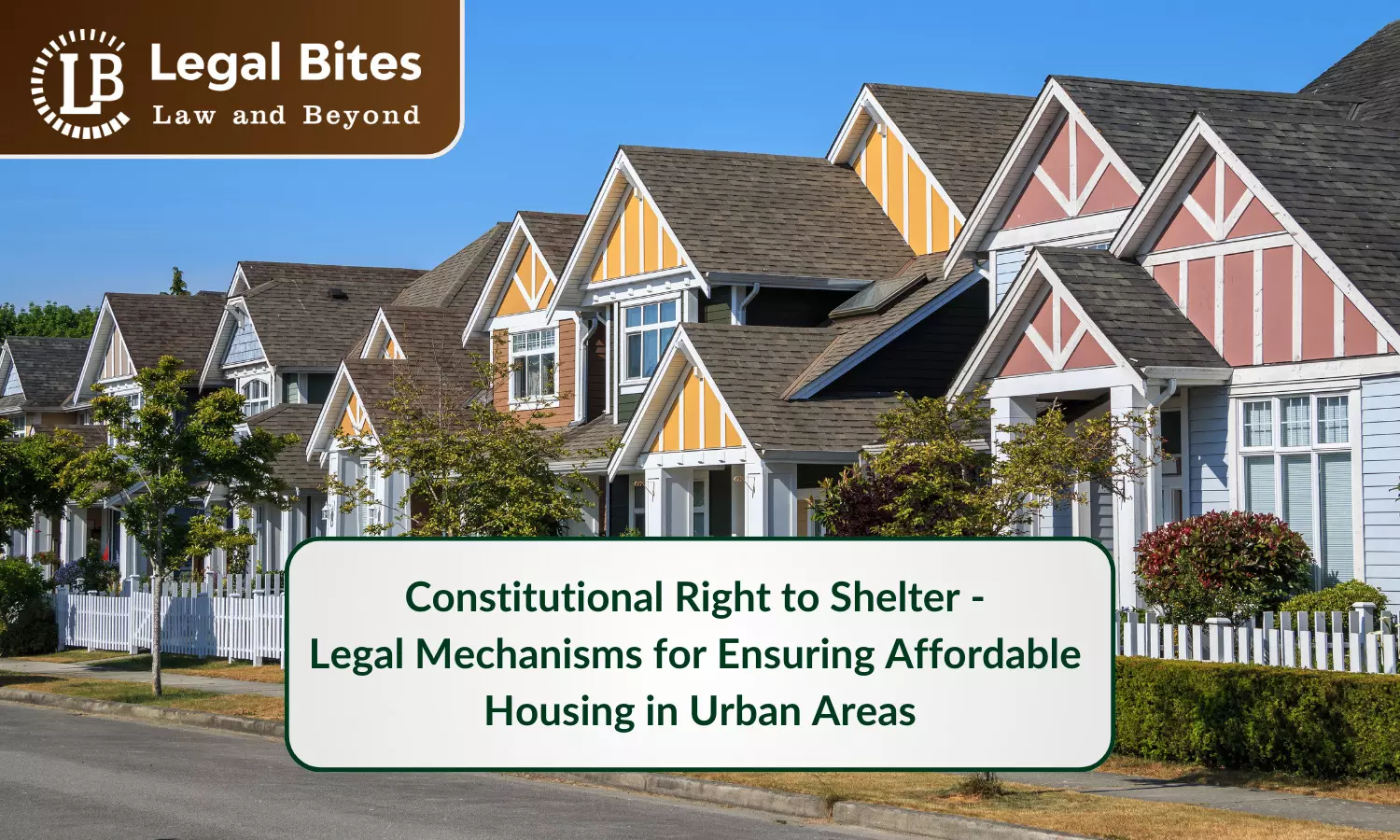Constitutional Right to Shelter - Legal Mechanisms for Ensuring Affordable Housing in Urban Areas
The Constitutional Right to Shelter ensures dignified housing for all, promoting social justice and equitable living standards in an inclusive society.

In this modern world, everyone deserves a roof over his head that is not just for show but should be a good fit for living and most importantly equally affordable. The nature and essence of the right to shelter can be seen from pre-historic times and in the lifestyle of animals, where they were eager to get shelter, have a decent life, and have a place to reside and rule thereafter. This right protected them when animals were in dire need of shelter to reside and protect themselves...
In this modern world, everyone deserves a roof over his head that is not just for show but should be a good fit for living and most importantly equally affordable. The nature and essence of the right to shelter can be seen from pre-historic times and in the lifestyle of animals, where they were eager to get shelter, have a decent life, and have a place to reside and rule thereafter. This right protected them when animals were in dire need of shelter to reside and protect themselves from severe weather conditions and predators. The right to shelter and affordable housing, a topic that has recently gained significant attention, has become a crucial agenda both internationally and nationally.
This is one of the most basic human rights and is an important part of human development. A shelter is a place where a man comes to rest after his hectic and tired schedule. This makes his shelter’s quality, quantity and affordability a very important ingredient in their life. This also has the potential to measure national income and a person’s consciousness. The right to housing forms an important social, economic and cultural right.
Indian Context: Right to Shelter
The right to property including compensation for the acquisition was initially a fundamental right under Article 19(1)(f) and Article 31 in the Indian Constitution available only to the citizens of India. However, through the 44th Amendment in 1978, it was categorised as a Constitutional right under the Article 300A.
Article 300A states: "No person shall be deprived of his property save by authority of law."
In the case of Olga Tellis v. Bombay Municipal Corporation (1985), the court observed that the right to shelter is a subset of the right to life guaranteed under the right to life because livelihood and shelter are essential to sustain life. Other cases include Chameli Singh v. State of Uttar Pradesh (1996), in which the Supreme Court ruled that the right to shelter is a fundamental right under Article 21 which includes adequate housing space, clean surroundings, water, air and sanitation. In Ahmadabad Municipal Corporation v. Nawab Khan Gulab Khan (1997), the Supreme Court directed the state government to provide affordable housing to the poor section of society. But it doesn't mean that one can encroach on footpaths, pavement and those places that are for public utility. The Court focused on the State's duty to prevent encroachment while balancing the right to life and livelihood under Articles 21 and 19(1)(e) of the Constitution.
In the case of In Re: Direction in the Matters of Demolition of Structures (2024), the court acknowledged that the right to shelter encompassed under Article 21, and it cannot be taken away because removing the roof from their heads is unconstitutional as it is a violation of Article 21 as the same directly impacts their livelihood. Shelter allows them to live with dignity. The court also observed that the demolition of the unauthorized part should be done only when it is the only option available so that it is not disproportionate, and the state must satisfy that it was the only way available, possible under the due process of law.
With a population of being more than population more than 1.5 billion India has now become the most populous country in the world. As per the report of UN-HABITAT, India is home to about 63% of the total slum dwellers in South Asia, and as per the 2001 census 78 million people are living without homes and many in overcrowded environments.
International Context: Right to Shelter
It is the responsibility of the states to make laws and policies which give shelter to homeless people. Considering this fact many states have adopted by signing MOUs of various organizations and being a part of conventions making it internationally binding. One such organization is UDHR (the Universal Declaration of Human Rights), 1948. In its Article 25(1), states:
“Everyone has the right to a standard of living adequate for the health and well-being of himself and of his family, including food, clothing, housing and medical care and necessary social services, and the right to security in the event of unemployment, sickness, disability, widowhood, old age or other lack of livelihood in circumstances beyond his control”.
This was one of the after-effects of World War II to end the cruelty towards humanity as the war displaced them from one place to another and made them homeless.
This also plays a role in sustainable development goals that are to be achieved by the year 2030. In these goals, one such goal talks about the right to shelter which is sustainable development goal 11, which says to provide cities and communities with houses and shelter that have a good quality and are affordable for the homeless section of the society.
India, since independence, has accepted some refugees from Bangladesh, Pakistan and other neighbouring countries that were earlier part of British territories. According to records with the Union Ministry of Home Affairs, as of January 1, 2021, there were 58,843 Sri Lankan refugees staying in 108 refugee camps in Tamil Nadu and 54 in Odisha and 72,312 Tibetan refugees have been living in India. India does not have a national law that is based on refugees but it accepts refugees based on the guiding principles of Jawaharlal Nehru in 1959. The Supreme Court has referred to Article 14 of UDHR and Article 13 of the International Covenant on Civil and Political Rights to emphasize the state's responsibility to provide housing, shelter, and livelihood to refugees under Article 21 of the Indian Constitution.
As India is not a signatory of the 1951 Refugee Convention and its 1967 Protocol, India deals with these cases based on political and administrative levels. There can be reasonable restrictions on fundamental rights, like in the case of Rohingyas, where refugees pose a security threat in areas like Delhi and Jammu, causing trafficking and other illegal activities.
Contemporary Relevance
If we talk about the period of prehistoric times, we see that primitive man was always in the race to first discover shelter to protect his family and also protect them from wildlife, extreme weather and other dangers. If we talk about settled civilizations like Mesopotamia or Mohenjo-Daro, their primary focus was towards permanent shelter that was near rivers, indicating that they searched for shelter where there were proper living conditions. Also, stable housing gives economic productivity, social development and cultural development.
In our sacred books and religions, they preach that homeless people should be provided shelter which is a moral duty. The Industrial Revolution played a vital role in making it even more important when it gave economic opportunity to all of them, they all gathered together and settled in slums which were in poor conditions for economic prosperity and upliftment. Later on for upliftment social activities were done and proper housing and shelter were given and evolved from the 20th century.
Conclusion
After going through the Article, we get to know the importance of the right to shelter aka the right to housing that is guaranteed under Articles 21 and 14 which was observed by the Supreme Court and High Court in various cases. This is a very important right for the refugees and for the people coming from other countries because their rights should also be respected and they should be given a proper livelihood and shelter but this is subject to reasonable restriction.
There have been several international organizations working on this like the UN which is the root of all in recognizing their right and making sure that injustice is not done to the people who are homeless. The importance of this right is just being recognized lately but from the contemporary time there has been a fight for proper shelter and housing as time evolved, there has been proper recognition of this right and is widely recognized.
References
[1] Constitution of India, 1950, Available Here
[2] Olga Tellis v. Bombay Municipal Corporation, 1985 SCC (3) 545
[3] Ahmadabad Municipal Corporation v. Nawab Khan Gulab Khan, AIR 1997 SC 152
[4] In Re: Direction in the Matters of Demolition of Structures [Writ Petition (Civil) No.295 of 2022]

